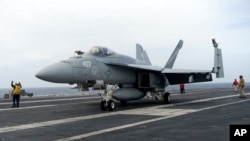South Korea is cautiously optimistic about alliance upgrades that the U.S. and Japan have planned to bolster security in East Asia and the Indo-Pacific region.
A South Korean Foreign Ministry spokesperson said the ministry “noted” that the U.S. and Japan, at their summit in Washington last week, spoke of “the defensive nature of the U.S.-Japan alliance” and emphasized “peace and stability” in the region.
The spokesperson continued via email to VOA’s Korean Service on Friday that “South Korea, the U.S. and Japan are making efforts to institutionalize expanded trilateral cooperation through agreements made at Camp David last year” and “to strengthen rules-based international order.”
The three countries held a trilateral summit at Camp David in August after Seoul and Tokyo mended ties frayed by disputes rooted in Japan’s colonial rule of the Korean Peninsula from 1910 to 1945.
At their bilateral summit held in Washington on April 10, Washington and Tokyo announced wide-ranging plans to revamp their military ties.
The plans include preparations for Japan to develop and produce with the U.S. military hardware, including hypersonic missile interceptors.
U.S. Ambassador to Japan Rahm Emanuel toured a Mitsubishi Heavy Industries F-35 fighter jet factory near Nagoya on Tuesday. He underlined the importance of Japan’s role in manufacturing weapons as U.S. supplies run thin amid crises in Europe and the Middle East.
The plans announced at the summit also call for Japan’s possible involvement in the AUKUS Pillar II security pact, enabling it to develop quantum computing, hypersonic, undersea and other advanced technologies.
AUKUS is a defense and security group of Australia, the United Kingdom and the United States. AUKUS Pillar 2 refers to a suite of cooperative activities conducted by the three nations to develop and field “advanced capabilities.”
Japan will hold trilateral exercises with the U.S. and the U.K. starting in 2025 as the Indo-Pacific and Euro-Atlantic regions become “ever-more linked,” according to the joint statement.
The plans call for Japan to expand its security role and arms buildup in tandem with efforts to implement a national security strategy issued in 2022. That called for an increase in Japan’s defense budget and a shift from a defense-only policy to one that includes counterstrike capabilities amid threats from North Korea and China.
In December, Japan eased its arms export control regime that had allowed it to sell components but not completed weapons.
Cho Han-Bum, a senior research fellow at the Korea Institute for National Unification, said “Japan’s arms reinforcement can be viewed as a double-edged sword.”
In an interview Monday with VOA’s Korean Service, he said the arms buildup significantly helps to deter threats from the Chinese military and North Korean nuclear weapons, but that it concerns South Korea.
Due to unresolved historical disputes from Japan’s colonization of Korea from 1910 to 1945, “trust” between the militaries of the two countries “is not restored fully,” even as they cooperate together now, he said.
South Korea, Japan, and the U.S. conducted a two-day joint naval exercise in the East China Sea from April 11 to 12. The exercise included anti-submarine warfare drills to counter North Korea’s underwater threats and interdiction drills aimed at blocking the North’s weapons shipments.
South Korea, under President Yoon Suk Yeol, has been pursuing a policy of rapprochement with Tokyo, and has aligned itself closely with Washington in countering Beijing’s economic and military coercion.
Under the previous administration of Moon Jae-in, Seoul relied for its security on the U.S. while bolstering economic relations with China. Ties with Tokyo remained tense.
Much of the anti-Japanese sentiment still runs high in South Korea, despite Yoon’s outreach to Tokyo, especially among progressives who increased their majority in an April 10 parliamentary election.
South Korea’s Foreign Ministry lodged a protest on Tuesday against Japan’s claim over a disputed island that sits midway between the two countries, called Dokdo by South Korea and Takeshima by Japan.
Won Gon Park, an adjunct professor of North Korean studies at Ewha Womans University in Seoul, said South Korea now has to “make a choice” whether to work more closely with Japan to counter threats from North Korea and China.
He said in an interview with VOA’s Korean Service that this might be necessary, as the U.S. builds a regional security structure to bolster defenses against China.
At their summit, the U.S. and Japan also announced a planned revision of the command structure of U.S. forces in Japan. This will complement Japan’s plan to establish a joint operations command to improve coordination of its air, ground, maritime forces by 2025.
Bruce Bennett, a senior defense analyst at the RAND Corporation, said Washington “is increasingly anxious to have global partners” step up their arms manufacturing because the U.S. is not producing enough military hardware to counter all the threats from Russia, China, North Korea and Iran.
Speaking with VOA by telephone on Friday, Bennett said what was announced at the summit was that “Japan would be a global partner,” enabling the U.S. to share highly sensitive “information, technology and other capabilities in exchange for taking responsibility with security and stability in the regions that go outside Northeast Asia.”
He added, “The U.S. recognizes South Korea can’t afford to send multiple divisions to other areas around the world because of the North Korean threats” but is “anxious” to have South Korea play a deeper global role, especially in the Indo-Pacific.
Kim Hyungjin contributed to the report.










